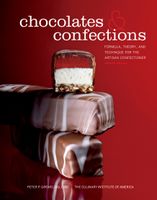Advertisement
Aerated Confections
Appears in
By Peter Greweling and Culinary Institute of America
Published 2007

Aerated confections are to the confectioner what mousses and soufflés are to the pastry chef: sweetened foams that may or may not contain inclusions.
In confections and desserts, the more effectively aerated a mixture is, the lighter the finished product will be—and the happier the consumer. Both aerated confections and mousses use some of the same ingredients for aeration, and the aeration of both is usually achieved by mechanical means. Aerated confections contain much less moisture than aerated desserts, however, and have a higher dissolved-solids content, with a corresponding low water-activity level, which provides the requisite shelf life. Among the most popular aerated confections are marshmallow, divinity, and nougat, all of which are mechanically leavened by whipping cooked sugars that are combined with an ingredient that acts as an aerator. Whipping is by far the most common method for aerating confections, but other methods are also used. Sponge candy is an example of an aerated confection that is chemically leavened using baking soda. And confectioners use pressurized gas to create the light texture of some confections such as milk chocolate soufflés. In all cases, the object is to incorporate gas bubbles into the mixture and trap them there to create a light product.

